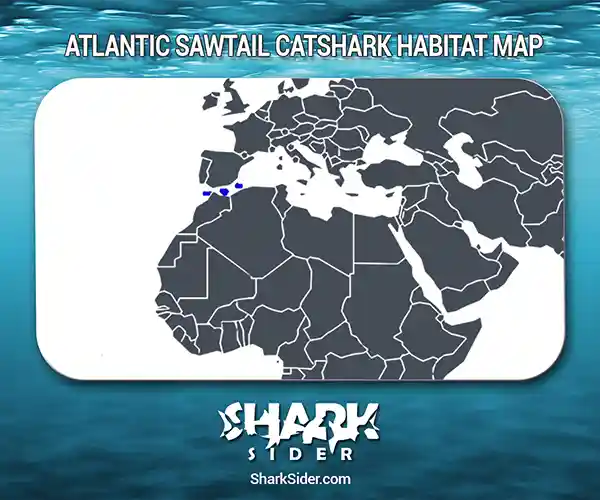The Atlantic Sawtail catshark is a lesser studied species of catshark found in a limited part of the northeastern Atlantic Ocean. Researchers initially misidentified it as the blackmouth catshark since they are very similar. However, in 2007 DNA tests proved that it is a separate species.
French naturalist Léon Louis Vaillant first described this fish in 1888, based on a specimen found in northwestern Morocco.
Atlantic Sawtail Catshark Scientific Classification |
|
| Kingdom | Animalia |
| Phylum | Chordata |
| Class | Chondrichthyes |
| Order | Carcharhiniformes |
| Family | Scyliorhinidae |
| Genus | Galeus |
| Scientific name | G. atlanticus |
Description
Mature males measure around 38-42 cm (1.2-1.4 ft), and females grow up to 40-45 cm (1.3-1.5 ft). The largest specimen ever caught measured 45 cm (1.5 ft).
Like the blackmouth catshark, the Atlantic sawtail catshark has a long, slender body with dark saddles and splotches along the back and tail, a black mouth cavity, and a crest of dermal denticles on the upper end of the caudal fin. They differ in the snout length and the color of the furrows beside their mouth.
The Atlantic sawtail catshark has a gray upper half and white underbelly, with dark blotches along the back and tail. Its head is flattened with a long, angular snout. The nostrils are placed farther from the tip than in the blackmouth catshark. It has oval eyes covered with nictitating eyelids. Its wide, curved mouth has furrows on the sides. Its small, sharp teeth are each flanked by narrow cusplets on either side. Five pairs of gill slits flank its sides.
The pectoral fins have rounded edges and are wide and large. The two dorsal fins are angular and similar-sized, having light rear ends. They are placed over the latter portions of the pelvic and anal fins, respectively. The short, low anal fins are located closer to the pointed and elongated anal fin.
Where do they live
Map Of The Atlantic Sawtail Catshark’s Habitat

The Atlantic sawtail catshark inhabits the northeastern Atlantic and the Mediterranean, in and around the Straits of Gibraltar. Its most significant abundance is in the Alborán Sea, around Isla de Alborán. There have also been sightings off the coast of Morocco and Mauritania.
It is a bottom-dwelling fishcommonly found on the continental shelf at depths of 400-600 m (1,300-2,000 ft).
Behavior
Dietary
They feed on crustaceans and small bony fishes.
Reproductive
Atlantic sawtail catsharks are oviparous and matE throughout the year. The females can carry up to nine eggs at once. The eggs are flask-shaped, with a reddish exterior, rounded bottom, and spiral horns at the corners. The males become sexually mature at 33 cm for malesand 37 cm for females.
Adaptations
They share similar predatory adaptations with other sharks, such as a keen sense of smell and sight, sharp, pointed teeth for catching prey, and smooth, streamlined bodies for faster movement.
Human interactions
They pose no threat to humans and have little to no commercial value. However, they inhabit regions where heavy commercial fishing is practiced, which could affect their population negatively. The IUCN has thus classified this species as “Near Threatened” or “NT.”
